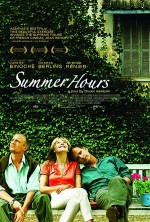Little Blossoms Adrift
2008 // USA - Korea // So Yong Kim // June 17, 2009 // Theatrical Print
[Treeless Mountain was recently featured in a limited engagement on June 17-19, 2009 at the Webster University Film Series.]
A- - Films about childhood abound, but So Yong Kim's delicate, affecting Treeless Mountain is a rarer thing: a film whose principal psychological attribute is its profound empathy for children, in a manner that never condescends or romanticizes. Painting in short strokes, Kim establishes an emotional wilderness of school-age loneliness, anxiety, and disillusionment. Seven-year-old protagonist Jin (Hee-yeon Kim) stands at the center of the film's story and visual language, but Kim, evincing a masterful talent for understated characterization and narrative, maintains a prudent and slightly saddened distance from her subject. She plumbs Jin's inner life by observing her face's restless contortions and her responses to the exasperating dilemmas that vex her and her little sister, Bin (Song-hee Kim). Kim's approach gently elevates the film from a poignantly observed tale of childhood, which would have been enough to satisfy, to an astonishingly mature examination of the ways in which naive expectations shape one's day-to-day habits, emotional topography, and interactions with others.
Treeless Mountain follows as responsibility for the care of Jin and Bin is passed along from their single mother to their father's sister, and then to their father's parents. From the adults' distracted perspective, this is essentially all that happens in the film. However, Kim examines these events from Jin's viewpoint, cultivating a secondary, more detailed plot about the effects that this sequence of uprootings has on the girls. While Kim provides just enough whispers and sharp words to suggest why Jin and Bin are shuffled from relative to relative, such matters are less salient to the film's thematic interests than the schemes and scrapes of the girls themselves. Thus, while there are vague asides about their absent, good-for-nothing father, much more attention is paid to the girls' cooking of crickets in a vacant lot, and their ad hoc play dates with a local boy with Down's Syndrome. Much of the "action"—if one can call it that—revolves around a particular totem: a cheap plastic piggy bank, which the girls believe will summon their mother if they fill it with coins accumulated via good behavior and guile.
The pacing of the film is both languid and fidgety, reflecting time's slow creep to a bored child and the anxiousness that an emotional upheaval so often engenders in kids. This unconventional cadence proceeds from Kim's distinctive style of film-making, if one allows that two features are sufficient to establish a "style" for a budding auteur. Her debut was the splendid In Between Days, a bitter fusion of an immigrant's tale and an adolescent romantic tragedy. There, as in her new film, her storytelling technique was marvelously lean, the narrative assembled from a succession of discomfiting, low-key confrontations, despairing interludes, and attentive observations. Despite this decidedly soft touch, at no time does Treeless Mountain suffer from narrative ambiguity. For a film with so little expository dialogue, it is remarkably precise, discovering through facial expressions, gestures, body language, and mumbled asides everything the viewer needs to know about Jin's predicament and her stance towards the world. Conspicuously, Kim brings her camera down roughly to the girl's eye level; low angles abound, and adults are often slightly out of frame or focus.
It would be excruciating to spend ninety minutes with the child characters from most films, but Jin possesses none of the forced charm or creepy adult mannerisms of such creatures. She is authentic and complex, alternately quiet, bold, manipulative, sulky, thoughtful, and quixotic. No mere cloying assemblage of adult neuroses, Jin behaves as a real child would in her circumstances. Several laudable films of recent vintage have used child actors to fine effect. Witness Simon Iteanu's luminous performance in Flight of the Red Balloon, or Catinca Untaru's scene-stealing in The Fall. With Hee-yeon Kim's Jin, Treeless Mountain achieves something equally fascinating: a seven-year-old heroine who engages not due to fantastic abilities, but due to her relatable qualities that transport us back to our own childhood aspirations, disappointments, and uncertainties.
Although Treeless Mountain is divisible into three narrative segments—mom, aunt, grandparents—these are not so much traditional dramatic acts as phases with distinct emotional and environmental qualities, each one containing abundant interactions and contrasts. Mom's urban apartment gives way to auntie's small-town cottage, and then to grandpa and grandma's farm. This outward migration is matched by Jin's meanderings through her own heart, as she attempts to deny and then reconcile her desires with the reality that the adults—those selfish, enigmatic beasts—have thrust upon her. Commerce is a central motif in Kim's story, exemplified by the girls' piggybank, but recurring in a variety of exchanges, rewards, gifts, and bribes, from auntie's attempt to extort money from the parent of a bully, to Jin's sly appearance at a cookie-dispensing household whenever she is hungry. Tellingly, the film lingers over little Bin's meticulous reconstruction of the piggybank's peeling eye with a magic marker. In this seemingly oblique scene, Kim foreshadows the moral thrust of her story. Jin must eventually abandon both the ruthless grasping of her lackluster adult role models and the magical thinking of her peers. With a little kindness and sensitivity, she may get halfway to the family she longs for.









